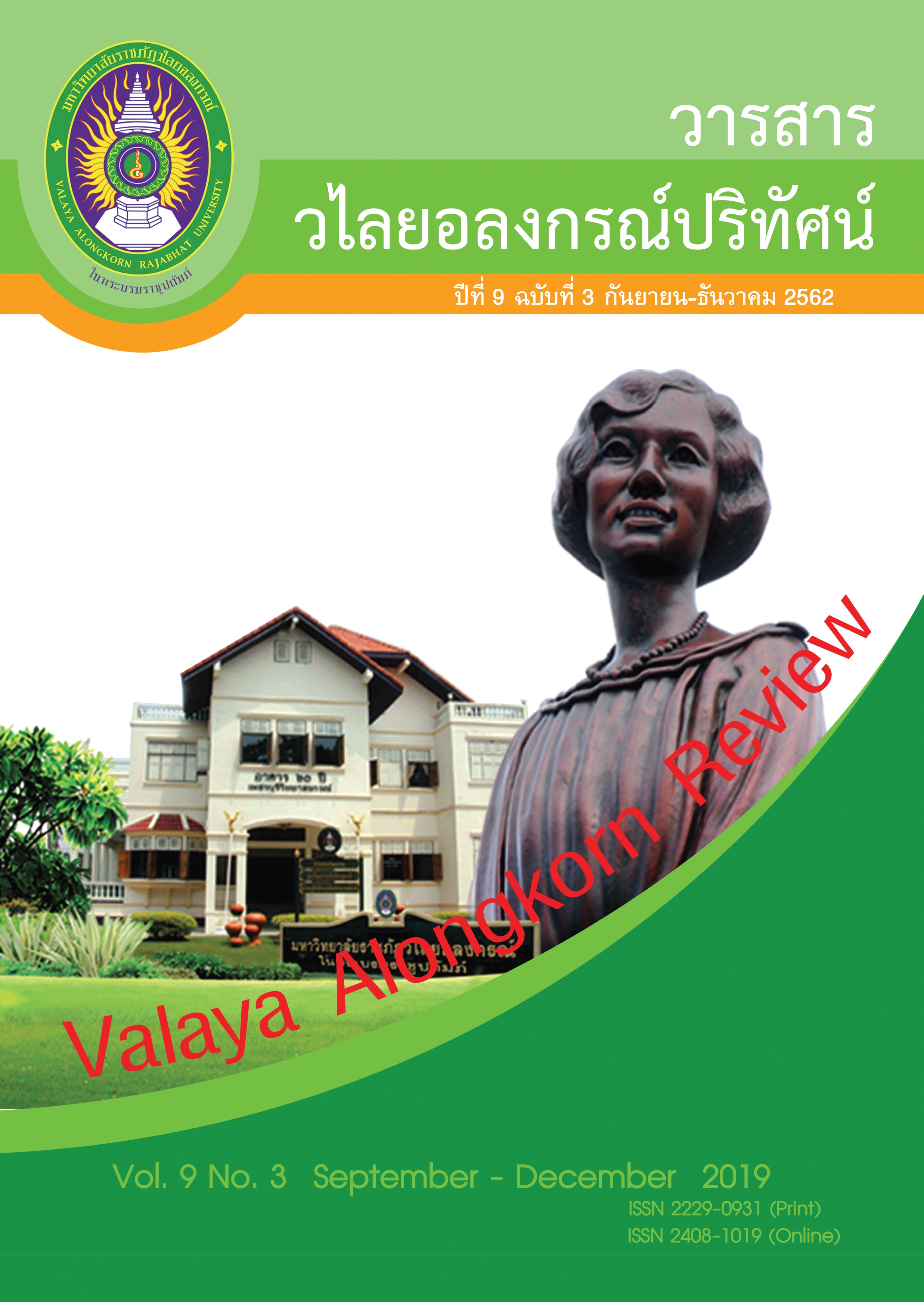การประเมินหลักสูตรครุศาสตรบัณฑิต 5 ปี สาขาวิชาคณิตศาสตร์ (หลักสูตรภาษาอังกฤษ) หลักสูตรใหม่ พ.ศ. 2557 คณะครุศาสตร์ มหาวิทยาลัยราชภัฏวไลยอลงกรณ์ ในพระบรมราชูปถัมภ์ จังหวัดปทุมธานี
คำสำคัญ:
การประเมินหลักสูตร, หลักสูตรครุศาสตรบัณฑิต 5 ปี, การประเมินแบบ CIPP MODELบทคัดย่อ
การวิจัยนี้มีวัตถุประสงค์เพื่อ 1) ประเมินหลักสูตรครุศาสตรบัณฑิต 5 ปี สาขาวิชาคณิตศาสตร์ (หลักสูตรภาษาอังกฤษ) หลักสูตรใหม่ พ.ศ. 2557 คณะครุศาสตร์ มหาวิทยาลัยราชภัฏ วไลยอลงกรณ์ ในพระบรมราชูปถัมภ์ และ 2) ศึกษาคุณลักษณะบัณฑิตที่พึงประสงค์ การประเมินหลักสูตรครั้งนี้ใช้รูปแบบ CIPP MODEL ทำการประเมิน 4 องค์ประกอบของหลักสูตร คือ องค์ประกอบ ด้านสภาวะแวดล้อม ด้านปัจจัยเบื้องต้น ด้านกระบวนการ และด้านผลผลิต กลุ่มตัวอย่างคือ ผู้บริหารและอาจารย์ผู้สอนหลักสูตรครุศาสตรบัณฑิต 5 ปี สาขาวิชาคณิตศาสตร์ (หลักสูตรภาษาอังกฤษ) จำนวน 8 คน นักศึกษาชั้นปีที่ 5 โปรแกรมคณิตศาสตร์ (หลักสูตรภาษาอังกฤษ) จำนวน 11 คน ผู้บริหารครูอาจารย์ในโรงเรียนร่วมปฏิบัติการสอนในสถานศึกษา 1 และ 2 จำนวน 31 คน เก็บรวบรวมข้อมูลโดยการวิเคราะห์เอกสารหลักสูตร การประชุมกลุ่มสัมภาษณ์และสอบถามกลุ่มเป้าหมาย เครื่องมือที่ใช้ในการศึกษาคือแบบสอบถามและแบบสัมภาษณ์ การวิเคราะห์ข้อมูลเชิงคุณภาพใช้การวิเคราะห์เนื้อหาหลักสูตรและการจัดกลุ่ม ข้อมูลเชิงปริมาณใช้โปรแกรมสำเร็จรูป Excel วิเคราะห์ค่าสถิติ ด้วยค่าเฉลี่ยเลขคณิต ค่าส่วนเบี่ยงเบนมาตรฐาน และแปลความหมายของค่าเฉลี่ยตามเกณฑ์ที่กำหนดของลิเคิร์ท
ผลการศึกษาพบว่า
1. ผลการประเมินองค์ประกอบด้านสภาวะแวดล้อม ซึ่งประกอบด้วย 3 ด้าน คือ วัตถุประสงค์ของหลักสูตร โครงสร้างและองค์ประกอบของหลักสูตร เนื้อหาสาระของหลักสูตร แต่ละด้านมีความเหมาะสมระดับมาก
2. ผลการประเมินองค์ประกอบด้านปัจจัยเบื้องต้น ซึ่งประกอบด้วย 3 ด้าน คือ คุณสมบัติของอาจารย์ผู้สอน ด้านนักศึกษา ปัจจัยสนับสนุนการศึกษา มีความเหมาะสมระดับมาก เหมาะสมระดับมาก และเหมาะสมระดับปานกลางตามลำดับ
3. ผลการประเมินองค์ประกอบด้านกระบวนการ ซึ่งประกอบด้วย 2 ด้าน คือ การจัดกระบวนการเรียนการสอน การปฏิบัติการสอนในสถานศึกษา ทั้งสององค์ประกอบมีความเหมาะสม ระดับมาก
4. ผลการประเมินองค์ประกอบด้านผลผลิต ซึ่งประกอบด้วย 6 ด้าน คือ คุณธรรมและจริยธรรม ความรู้ที่ได้รับ ทักษะทางปัญญา ทักษะการวิเคราะห์เชิงตัวเลข การสื่อสารและการใช้เทคโนโลยี ทักษะการจัดการเรียนรู้ มีความเหมาะสมระดับมาก สำหรับทักษะความสัมพันธ์ระหว่างบุคคลและความรับผิดชอบมีความเหมาะสมระดับมากที่สุด
5. ผลการประเมินคุณลักษณะบัณฑิตที่พึงประสงค์ ด้านคุณธรรมและจริยธรรม ความรู้ ที่ได้รับ ทักษะทางปัญญา ทักษะความสัมพันธ์ระหว่างบุคคลและความรับผิดชอบ มีความเหมาะสม ในระดับมากที่สุด ส่วนทักษะการวิเคราะห์เชิงตัวเลข การสื่อสารและการใช้เทคโนโลยี ทักษะ การจัดการเรียนรู้ มีความเหมาะสมระดับมาก
ผลการประเมินจากการประชุมกลุ่ม สรุปได้ว่า หลักสูตรครุศาสตรบัณฑิต 5 ปี สาขาวิชาคณิตศาสตร์ (หลักสูตรภาษาอังกฤษ) ประกอบด้วยเนื้อหาคณิตศาสตร์ค่อนข้างมากและเนื้อหาคณิตศาสตร์บางวิชามีความซ้ำซ้อน มีช่องว่างและความแตกต่างระหว่างคณิตศาสตร์ระดับมหาวิทยาลัยและคณิตศาสตร์ระดับโรงเรียนมาก เห็นควรปรับเปลี่ยนรายวิชาคณิตศาสตร์ที่มี ความซ้ำซ้อนเป็นเนื้อหาคณิตศาสตร์แนวใหม่ระดับโรงเรียนและเพิ่มรายวิชาที่เป็นการบูรณาการระหว่างเนื้อหาคณิตศาสตร์กับการสอนในโรงเรียนให้มากขึ้น
เอกสารอ้างอิง
เบลลันกา, เจมส์ และแบรนต์, รอน. (บก.). (2554). ทักษะแห่งอนาคตใหม่: การศึกษาเพื่อศตวรรษที่ 21. (แปลจาก 21st Century Skills: Rethinking How Students Learn โดย วรพจน์ วงศ์กิจรุ่งเรือง และอธิป จิตตฤกษ์). กรุงเทพฯ: โอเพ่นเวิลด์ส.
มหาวิทยาลัยราชภัฏวไลยอลงกรณ์ ในพระบรมราชูปถัมภ์. (2562). หลักสูตรครุศาสตรบัณฑิต สาขาวิชาคณิตศาสตร์ (4 ปี) หลักสูตรภาษาอังกฤษ หลักสูตรปรับปรุง พ.ศ. 2562. ปทุมธานี: คณะครุศาสตร์ มหาวิทยาลัยราชภัฏวไลยอลงกรณ์ ในพระบรมราชูปถัมภ์.
อิศเรศ พิพัฒน์มงคลพร และคณะ. (2556). รายงานการวิจัยการประเมินหลักสูตร ศึกษาศาสตรบัณฑิต สาขาวิชาการประถมศึกษา คณะศึกษาศาสตร์ มหาวิทยาลัยศิลปากร. นครปฐม: คณะศึกษาศาสตร์ มหาวิทยาลัยศิลปากร.
อุดม คชินทร, สมบัติ นพรัตน์ และดิเรก พรสีมา. (2561). เปิดแนวคิดปรับหลักสูตรผลิตครู ทางเลือกใหม่สนองโลกศตวรรษที่ 21. ไทยรัฐ. [ออนไลน์], เข้าถึงได้จาก https://www.thairath.co.th/news/local/1405760. (2561, 5 มิถุนายน).
Taba, H. (1962). Curriculum Development Theory and Practice. New York, Chicago, San Francisco, Atlanta: Harcourt, Brace & World, Inc.
Sucheera Phattharayuttawat, Jariya Chantra & Wilasinee Chaiyasit. (2009). An evaluation of the curriculum of a graduate programme in Clinical Psychology. [Online] Available: https://bit.ly/2JxZJn0. (2561, 17 January).
Stufflebeam, D. L., et al. (1971). Educational Evaluation and Decision-Making. Itasca, Illinois: Peacock Publishing.
ดาวน์โหลด
เผยแพร่แล้ว
รูปแบบการอ้างอิง
ฉบับ
ประเภทบทความ
สัญญาอนุญาต

อนุญาตภายใต้เงื่อนไข Creative Commons Attribution-NonCommercial-NoDerivatives 4.0 International License.
ข้อความที่ปรากฏในบทความแต่ละเรื่องในวารสารวไลยอลงกรณ์ปริทัศน์ เป็นความคิดเห็นของผู้นิพนธ์แต่ละท่าน มิใช่เป็นทัศนะและมิใช่ความรับผิดชอบของกองบรรณาธิการจัดทำวารสาร และ
มหาวิทยาลัยราชภัฏวไลยอลงกรณ์ ในพระบรมราชูปถัมภ์


